Introduction
One of the foremost characteristics of films Noir is the fact that even today, the majority of movie critics continue to debate on whether Noir should be referred to as the legitimate cinematographic genre or to be considered merely the distinctively stylish conceptualization of crime-dramas, closely associated with the existentialist motif of disillusionment and with the expressionist methodology of film-editing. For example, according to Hirsch (1981, p. 72), “Noir tells its stories in a particular way, and a particular visual style. The repeated use of narrative and visual structures… certainly qualifies noir as a genre, one that is as heavily coded as the western”. After all, there can be indeed little doubt as to the fact that most films Noir are being concerned with exploring the theme of crime and punishment, and that there is an unmistakable ‘dark’ distinctiveness to the particulars of these films’ mise-en-scenes and the deployed editing techniques.
There are, however, many film critics who do not subscribe to Hirsch’s suggestion, in this respect, as they believe that it is specifically the Noir films’ mood and tone, which makes it possible to categorize these films qualitatively. Nevertheless, given the fact that tone and mood are the essentially discursive notions, there can be no time-resistant subtleties to them, by definition. In its turn, this implies that just about any definition of Noir as a genre, given at a particular point of time, can only be considered conceptually legitimate in regards to the provisions of what used to be the dominant socio-cultural discourse, at the time of this definition’s coining. What it means is that there can be no fixed definitions of Noir, in the first place. As Spicer (2002, p. 24) had put it, “Any attempt at defining film noir solely through its ‘essential’ formal components proves to be reductive and unsatisfactory because film noir, as the French critics asserted from the beginning, also involves a sensibility, a particular way of looking at the world”. At the same time, however, there is a certain rationale to suggestions that, even though Noir cannot be defined as a cinematographic genre, in the conventional sense of this word, it nevertheless can be defined as such from the perspective of Platonic metaphysics. According to Plato, the essence of a particular phenomenon, as ‘thing in itself’, can be exposed by the mean of analyzing the discursive significance of this phenomenon’s different emanations. In regards to films Noir, this idea can be reformulated as follows: it should prove possible to define the spatially transforming metaphysical significance of Noir, as a unique cinematographic philosophy/genre, by the mean of analyzing the qualitative aspects of tone and mood in Noir movies, interpreting these aspects’ discursive connotation, and defining the extent of the deployed editing techniques’ compatibility with the connoted message.
In this study, I will aim to do just that, while referring to Noir (and consequentially to neo-Noir) film as the one among many intellectual byproducts of the Western civilization’s disillusionment with the values of Enlightenment and with the idea that it is in the humanity’s very nature to remain on the path of linearly defined continuous advancement. I will also strive to expose the nature of this disillusionment, as the consequence of the extent of Westerners’ biological vitality becoming progressively weakened. For this purpose, I will assess the discursive significance of films Noir and neo-Noir through the conceptual lenses of Spengler’s cyclical theory of ‘three generations’. This is because there are a number of objective reasons to believe that Noir films particularly appeal to the representatives of the ‘third generation’ of Westerners, deprived of their ancestors’ senses of will-power, which in turn causes them to adopt an essentially decadent stance, while addressing their Faustian existential anxieties.
Historical retrospective/Main features
The discursive origins of Noir cinematographic genre/style can be traced back to the German Expressionist movement, which used to be considered a trademark of German cinematography through 1920-1930, on the one hand, and to the movement of poetic realism, which was particularly popular among French moviemakers, during 20th century’s forties, on the other. The German advocates of Expressionism in cinematography (such as Fritz Lang and Robert Siodmak) promoted the idea that motion picture should be considered a fully independent art-form. They believed that, just as it is being the case with composers, who construct a melody out of individually sounding and often dissonant musical notes, movie directors endow a particular scene with a semiotic significance by the mean of ensuring this scene’s contextual wholesomeness. Hence, the subtleties of an expressionist/formalist editing, “The environment of the scene is the source of the images. Long shots are rare. Instead, a barrage of close-ups (often of objects) provides the audience with the necessary associations to link together the meaning” (Gianetti, 2001, p. 157). The French adherents of poetic realism, on the other hand (such as Jean Renoir and Pierre Chenal), believed that it is specifically savoring the aesthetic aspects of the film characters’ existential deterioration, which should be considered a cinematography’s foremost aim. This is because by being encouraged to seek aesthetics in negativity, viewers would grow less emotionally prone to such a negativity. In its turn, this partially explains why, throughout forties, the majority of directors affiliated with Noir, used to make an excessive use of expressionist editing techniques and to strive towards endowing their films’ themes and motifs with morally ambivalent sounding.
As of today, it became a common assumption among many film critics that the era of classical Noir films extends from 1941, which saw the production of John Huston’s The Maltese Falcon, to 1958, when Orson Welles produced his movie Touch of evil. Nevertheless, it was not up until 1946 that the term ‘noir’ was first applied in French film magazines, as the qualitative definition of crime-fiction films, which featured the motifs of existential alienation, socially inappropriate sexuality, moral ambivalence, perceptional cynicism, psychological inadequacy and the elements of expressionist editing. According to Conard (2006, p. 17), “(Noir is) the inversion of traditional values and the loss of the meaning of things. That is, at the heart of the noir mood or tone of alienation, pessimism, and cynicism we find, on the one hand, the rejection or loss of clearly defined ethical values”. The fact that classical Noir crime-fiction movies contain the earlier mentioned motifs, and the fact that the elements of expressionist editing (such as the spatial discontinuity between takes, the mise-en-scenic dramatization of contrasts between light and darkness, the presence of an off-screen narration, etc.) make Noir films rather decadently ‘artsy’, provides a possibility for these movies’ identification, as such that do belong to a well defined cinematographic genre.
Unlike what it used to be the case in classical crime-fiction movies of the era, concerned with exploring the theme of a police investigator/private eye relying on its sense of rationale, as the actual instrument of catching criminals for society’s betterment, in films Noire protagonists are rarely being concerned with promoting the euro-centric agenda of a society’s rationale-driven betterment. Instead, Noir protagonist (very often a private eye) seeks to attain an emotional comfortableness with what he perceives as the irrational ways of universe, reflected by people’s tendency to succumb to corruption. Whereas, the pre-Noir protagonists in movies based upon 19th century’s crime-novels (such as Arthur Conan Doyle’s stories about Sherlock Holmes) always do find the way of the labyrinth of unsolved crimes, without having been personally affected by their close and personal encounters with the extrapolations of people’s criminal-mindedness, Noir protagonists usually end up being effectively locked in such a labyrinth. In its turn, this often results in these protagonists adopting the identity of their adversaries. As it was pointed out by Abrams (2006, p. 74), “Whereas, the maze of the classic detective form represents a mannerist maze (with an escape), the maze of the noir detective form is a rhizomatic maze (without an escape)”. The earlier mentioned thematic characteristics of film Noir can be well seen in such classical Noir movies as Howard Hawks’ (1946) The big sleep, Tay Garnett’s (1946) The postman always rings twice (1946), Billy Wilder’s (1944) Double indemnity and Jacques Tourner’s, (1953) Out of the past. After all, even though that each of these films features its unique plot, they nevertheless can be well discussed as such that promote the idea that one’s tendency to tackle life’s challenges rationally may never guarantee a positive outcome.
At the same time, however, it would be quite inappropriate to think that the plots of classical Noir films are being solely concerned with the theme of a criminal investigation. After all, had it been the case, the issue of whether Noir can be considered a legitimate cinematographic genre would not remain the subject of an ongoing debate. Even though that the motif of crime is being present in just about every classical film Noir, there can be no a universally recognized definition to what constitutes a classical Noir plot. Whereas, the plots of a bulk of classical Noir films, associated with American-born directors, indeed feature the process of a criminal investigation in making, the plots of many classical Noir films, directed by Jewish émigrés from Germany (who came to U.S. in thirties), revolve around a number of clearly Freudian issues, concerned with how people go about addressing their deed-seated subconscious anxieties. According to Biesen (2010, p. 90), “The American hard-boiled detective, so characteristic of film noir, is absent in the Jewish émigrés’ films… featuring ‘soft’ protagonist, such as a banker (Lang’s Scarlet street) or a pianist (Ulmer’s Detour)”. The heavily feminized specifics of Jewish upbringing in pre-WW2 Europe, had naturally predisposed Jewish émigré–directors to hypertrophy the role of women, within the context of what defines the very essence of societal dynamics – this particular idea will be explored at length later. In its turn, this partially explains the origins of another prominent motif in classical Noir movies – the motif of a femme fatale. The term femme fatale refer to the so-called ‘fateful (literally – fatal) women’, known for their ability to use female charms, as the mean of advancing their down-to-earth agenda – often at the expense of murdering their naïve male lovers or driving them to the point of committing a suicide.
Initially, the majority of classical Noir movies were considered belonging to the B-category (low-budgeted) of Hollywood films. The most notable examples of these films are Alfred Hitchcock’s 1951Strangers on a train, Robert Wise’s 1947 Born to kill and Anthony Mann’s 1948 Raw deal. Nevertheless, as it was becoming increasingly clear to Hollywood directors that there was indeed a popular demand for ‘criminal melodramas’ (the term Noir was virtually unknown at the time), more and more Noir movies were falling into the A-category (high-budgeted). John Huston’s 1948 Key Largo and 1950 The asphalt Jungle represent the examples of specifically high-budgeted Noir films.
The decline of Noir movies’ popularity through late fifties is now being assumed to have been brought about by the fact that by that time, Hollywood directors have gained a full conceptual awareness of Noir, as a unique cinematographic genre. In its turn, such their newly acquired awareness had undermined their ability to explore the ‘noirish’ themes and motifs outside of what became the Noir films’ established editing and thematic conventions. As a result, the plots and the explored themes in many late Noir movies had to an extent ceased being thoroughly original. As Naremore (1995-1996, p. 19) noted it, “By the late 1950s… social criticism (in Noir movies) was smothered by banal plot conventions, and ‘incoherence’ became predictable”. Nevertheless, there appears to have been another factor that contributed towards the process of classical Noir films falling out of favor with moviegoers at the time – the fact that, throughout the earlier mentioned historical period, the representatives of the so-called generation of ‘baby boomers’ began to constitute the ever increasing share of American moviegoers. Given the fact that the baby-boomers foremost psychological traits have traditionally been considered their perceptional optimism and their belief in the progress’s linearity, it is fully explainable why they could not quite relate to the motifs of existential alienation and moral ambiguity, commonly explored in classical Noir films. The validity of this statement will be illustrated later, in regards to what I believe constituted the metaphysical/discursive preconditions for the growing popularity of neo-Noir cinematographic genre/style, throughout seventies, eighties and nineties.
Noir’s discursive significance
As it was mentioned earlier, even though that the cinematographic manifestations of Noir genre can be hardly categorized, as the mean of exposing these manifestations’ spatially intact technical consistency, they nevertheless can serve as a key to understanding the Noir’s metaphysical roots as ‘thing in itself’. Therefore, for just about anyone who strives to gain an in-depth insight as to what predetermined the emergence of this specific genre/style, it represents the matter of a crucial important to be thoroughly knowledgeable of what accounted for the qualitative aspects of Western socio-philosophical discourse, throughout thirties and forties. The reason for this is apparent – once we are being aware of how people used to perceive the surrounding reality and their place in it, throughout a particular historical period, we will be in a position to define what caused them to adopt a specific attitude towards this reality’s cinematographic representations (Foucault, 1978).
One of the principal particulars of a Western living, through thirties and forties, was the fact that, during this specific historical period, the pace of secularization in Western societies had become exponential to the flow of time. Such an eventual development was bound to happen, as even by the end of 19th century, the theological fallaciousness of Christianity became clear to just about anyone capable of thinking logically, “In the late nineteenth century… Reason and science were destroying the foundation of superstition and ignorance on which the Church rested” (Hadden 1987, p. 590). However, even though that the groundbreaking scientific discoveries in a number of different fields, which had taken place throughout the 20th century’s early phase, did contribute to the improvement of people’s living standards, these discoveries also resulted in depriving Westerners of a belief in the orderly essence of universe’s mechanics. In the article from which we have already quoted, Conard states, “Before the death of God (at the beginning of 20th century), we knew as good Platonists or Christians who and what we were, the value and meaning our lives had… Now we’re set adrift. We’re alienated, disoriented, off balance. The world is senseless and chaotic. There’s no transcendent meaning or value to human existence” (p. 18). Probably the biggest blow to the idea of an orderly universe has been dealt by the Einstein’s Theory of Relativity, which had a number of clearly ethical implications. The foremost of these implications was the fact that Einstein’s theory indirectly exposed the sheer fallaciousness of the assumption that ethical categories represent a universally recognized value, regardless of the affiliated circumstances (Staley, 2009). The experiences of Great Depression had a similar effect on the formation of people’s worldviews in Western countries (particularly in America), in a respect that these experiences confirmed the situational relativity of a number of formerly assumed objective notions. Because of that, post-Depression Americans were growing increasingly alienated from the rationale-based idea that the accumulated material riches cannot disappear into the thin air within a matter of few hours. This, of course, contributed even further to the process of Westerners growing progressively disoriented, in the existential sense of this word.
The people’s experiences, related to WW1/WW2 and Great Depression, confirmed the ‘death of God’ and the implicational relativity of moral dogmas in their eyes even further. Given the fact that WW1 and WW2 resulted in transforming the ‘art of war’ into the ‘art’ of a wholesale slaughter, it does not come as a particular surprise why contemporaries used to refer to this particular war as yet additional proof that there is no God. The realities of both World Wars freed intellectually advanced Westerners of their last remaining illusions as to the ‘intrinsic value’ of human life.
In their turn, the earlier mentioned discursive aspects of the early 20th century’s living, created objective preconditions for the emergence of a new trend in Western philosophy – existentialism. According to Porfirio (1976, p. 81), “Existentialism is an outlook which begins with a disoriented individual facing a confused world that he cannot accept. It places its emphasis on man’s contingency in a world where there are no transcendental values or moral absolutes, a world devoid of any meaning but the one man himself creates”. One does not have to be overly analytical to realize that this particular definition of existentialism is being thoroughly consistent with the earlier outlined foremost themes and motifs in classical Noir films.
Just as it happened to be the case with an ‘existentialist individual’, who is being continually forced to address life’s absurdity, classical Noir characters also struggle hard to construct a some kind of a logically-sound framework for what they perceive as the essentially odd and often absurdist life-challenges. Yet, since the existentialist outlook on life denies the very possibility that there might be an innate logic to the reality’s emanations, the majority of Noir characters end up sustaining an utter fiasco in such their endeavor.
The legitimacy of this suggestion can be well illustrated in regards to the character of Joseph Gillis (William Holden) in Billy Wilder’s 1950 film Sunset boulevard. After having met the aging movie-star Norma Desmond (Gloria Swanson), who later is being revealed a mentally inadequate woman, Joseph decides to stick up with Norma’s offer to stay at her house and to work on editing her screenplay for the movie, in which she expects to play a leading role. As the plot unravels, Joseph begins to realize that Norma is courting him, as she never ceases to bestow expensive give upon him, while demanding Joseph’s affection in return. Deep inside, Joseph realizes that this situation is being morally repugnant, as he is being forced to fake his love to a mentally deficient woman, who also happened to be much older than he was. Yet, Joseph tries to lessen the acuteness of his anxieties, in this respect, by the mean of rationalizing his morally inappropriate behavior, as the mean of enjoying a financial security, which he failed to achieve while on its own. There is a memorable scene in the movie, in which after having invited Betty Schaefer (Nancy Olson) to visit him at Norma’s house, and after having revealed the actual source of his riches, Joseph declines Betty’s offer to leave Norma, while saying, “Look, sweetie — be practical. I’ve got a good thing here. A long-term contract with no options. I like it that way. Maybe it’s not very admirable. Well, you and Artie can be admirable” (01.33.23). There are, however, a number of previously unmentioned discursive overtones to this scene.
It suggests that, even though during Noir classical era, the existentialist philosophy was indeed becoming ever more popular (which came hand in hand with the process of a public sphere’s desacralization), the qualitative characteristics of a public discourse, concerned with secularization and ‘essentialization’, do not alone explain the themes and motifs of classical Noir movies. The reason for this is apparent – as it appears from the earlier mentioned scene, Joseph’s demise did not come because of his existential disorientation. After all, there can be little doubt about him having been a practically-minded individual, capable of relying on its sense of rationale, while dealing with issues. Rather, Joseph possessed a very little will-power (a masculine virtue), which in turn prevented him from deciding to leave Norma, before it was too late.
This observation provides us with a qualitatively new perspective, from which the discursive significance of classical Noir films should be assessed. This perspective is being concerned with the Spengler’s (1923) concept of ‘three cyclical generations’. According to this concept, the history of Western civilization can be thought of as the cyclical succession of generations, the representatives of which possess a number of unique psychological traits. For example, in Homer’s poems, the majority of characters are being defined almost exclusively by the sheer strength of their will-power. There is nothing else about them. Such people are usually being referred to as representatives of the ‘first generation’ of Westerners (Whites). They are the fathers of nations, great military leaders and explorers. The history of their lives is read like an epic. People that belong to the ‘second generation’, on the other hand, have both – strength (will-power) and intellect. They are the ones who build and conquer, while strengthening the foundation of earlier accomplishments, on the part of their ancestors. Martin Luther, Columbus, and Shakespeare, for example, are the typical representatives of the ‘second generation’ of Westerners. As history progresses, however, people are becoming increasingly detached from the masculine virtue of will-power, while retaining their intellect alone. Without being capable of acting as ‘necessary’, as opposed to acting ‘as it feels like’, these people slowly succumb to cognitive/perceptional decadence, reflected by their tendency to indulge in a number of different degenerate activities, which in turn makes them the affiliates of the ‘third generation’ of Westerners.
For example, many representatives of the early 20th century’s Western intellectual elite, such as Sigmund Freud, used to be heavily depended on drugs. Some particularly ‘progressive’ artists and poets, such as Kasimir Malevich and Jean Rimbaud, used to swallow small amounts of poison, for their skin to appear extra-pale, as a skin-paleness was considered fashionable at the time. Nowadays, despite the fact that geopolitically speaking, Western countries enjoy an undisputed geopolitical dominance in the world, these countries are being simultaneously ‘colonised’ by the hordes of legal and illegal immigrants from the Third World (the policy of multiculturalism). This serves as an indication that the ‘third generation’ decadents continue to account for the overwhelming majority of today’s Western politicians, whose dispossession of masculine psychological qualities does not allow them to properly utilize their intellect
The earlier provided brief outline of Spengler’s concept directly relates to this study’s subject matter. This is because it points out to the fact that even though it is fully appropriate to think of Noir cinematographic genre/style as being closely associated the 20th century’s existentialist philosophy, the emergence of this philosophy cannot be regarded as such that has been solely brought about by what Nietzsche used to refer to as the ‘death of God’, induced by an ongoing scientific progress. After all, even though that de jure speaking, the ‘God’ is still being regarded well and alive in just about every Western country (particularly in U.S., where the Christian lobby is being especially powerful), he has been de facto ‘dead’ ever since the beginning of Reformation movement in Europe. After all, the Protestant Christianity, as a quasi-religious philosophy of material enrichment (according to Protestants, the extent of a particular individual’s financial well-being is being reflective of whether God favours him/her or not), is conceptually opposite to the Christianity’s original spirit (Weber, 1905). Yet, it would prove quite impossible to pin point even at the single European work of art or literature, produced in Protestant countries through 17th-19th centuries, with clearly defined motifs of existential decadence to them.
What it means is that, contrary to what the majority of contemporary movie-critics imply, the true significance of Noir cinematographic genre style should be explored within the context of what represents the innate (not external) cause of people’s existential disorientation, sublimated in their often visible behavioural/cognitive decadence. The Spengler’s concept of ‘three generations’ comes in particularly helpful, in this respect. This is because it points out to the fact that it is not the people’s realization of God’s non-existence and their increasing awareness of the universe’s actual laws, which prompts them to indulge in socially inappropriate and morally ambivalent behaviour (as seen in classical Noir movies), but namely their undermined ability to exercise a will-power-fuelled authority over nature. This is the reason why a classical Noir character always strives to ‘orient’ among the challenges that he or she faces, as opposed to addressing them directly.
What causes people to act as the typical representatives of the ‘third generation’, in general, and classical Noir characters to adopt an escapist attitude towards life, in particular? To answer this question, we will have to expound on what accounts for the workings of what Spengler used to refer to as the ‘Faustian psyche’. According to Spengler (1923, p. 175), “The prime symbol of the Faustian (Western) soul (is) Limitless Space. And those specially Western creations of the soul-myth called ‘Will’, ‘Force’ and ‘Deed’ must be regarded as derivatives of this prime symbol”. This is reason why, unlike what is being the case with the affiliates of ‘holistic’ (Eastern/Asian) cultures, it is in the very nature of White people to strive towards nature’s ‘objectivization’ – often by the mean of imposing their will upon others. As it was pointed out by Greenwood (2009, p. 53), Faustian existential values are based upon the assumption that, “Individual’s will-power must never cease combating obstacles, that the catastrophes of existence come as an inevitable culmination of past choices and experiences, and that the conflict is the essence of existence”. By acting in such a manner, intellectually uncorrupted Westerners used to position themselves as being nothing short of semi-Gods, which in turn suggests that there was nothing incidental to the fact that, as of the end of 19th century, Western countries have secured a complete mastery over the world.
Nevertheless, it is specifically when Westerners project their Faustian aspirations (which derive out of their inborn sense of existential idealism) into ‘infinity’, that they can continue advancing socially, technologically and culturally. Yet, for them to be able to do this, Westerners may never cease being endowed with the sense of a strongly defined will-power. Once, however, this sense in Westerners becomes weakened, their psyche ends up projecting its idealistic anxieties inwards (into unconsciousness), which in turn causes the concerned individuals a great deal of existential frustration and confusion. The reason for this is apparent – once the people’s inborn sense of Faustian idealism is being ‘locked’ inside, their intellect ends up being left ‘unsupervised’. Therefore, there is nothing particularly odd about the fact that many Noir movies promote the idea that the extent of people’s intellectual advancement positively correlates with the measure of their moral wickedness/cynicism.
Alfred Hitchcock’s 1951 film Strangers on a train is being fully illustrative of the earlier suggestion’s soundness. In it, the character of Bruno Anthony (Robert Walker) proposes a plan to a perfect stranger, he just met on a train (Guy Haines played by Farley Granger) to participate in the ‘criss-cross’ murder-scheme. The scheme would involve Bruno killing the Guy’s estranged wife, who was not willing to give him a divorce, in return for Guy killing the Bruno’s overly authoritarian father. Even though that Guy initially refuses to even consider participating in this scheme, as clearly the by-product of Bruno’s mental abnormality, as time goes on, Guy realises that he is being left with less and less options, but to agree to Bruno’s proposition. This was because, despite acting in a mentally deranged manner, Bruno has nevertheless proven himself an extremely intelligent person, capable of taking the knowledge of other people’s psychological weaknesses to his advantage. Moreover, unlike what it was the case with Guy, who could have indeed benefited from his morally wicked wife’s disappearance, Bruno did not have any rational reason to be wishing for his father’s death. His murderous intention, in this respect, appears to have been motivated by the fact that Bruno was nothing but a self-indulgent decadent, deprived of a will-power to lead the lifestyle of a socially responsible individual, “Bruno: I hate him (father). He thinks I ought to catch the eight-five bus every morning, punch a time-clock and work my way up selling paint or something. Him – with all his money!” (00.06.30). Had Bruno been capable of applying a will-powered effort into exploring its intelligence’s full potential in a socially-appropriate manner, he could have easily gained a social prominence. Instead, he ended up becoming nothing short of a socially dangerous maniac. As such, the character of Bruno represents the classical example of a typical representative of the ‘third generation’ – a thoroughly intelligent but mentally corrupted individual, incapable of acting as the society’s productive member.
It is quite challengeable to define what triggered the process of more and more people in Western countries starting to exhibit the psychological traits of the ‘third generation’ decadents precisely. Nevertheless, there can be few doubts as to the fact that this process came hand in hand with the process of Westerners becoming increasingly feminized (the process which results in weakening masculine psychological qualities in people), in the cognitive and perceptional senses of this word. The subtleties of Western societies’ ongoing ‘feminization’, however, cannot be discussed outside of what accounts for the intrinsic characteristics of Jewish cultural/religious tradition, on the one hand, and how Jewish intellectuals, affiliated with this tradition, created objective preconditions for the emergence of Noir cinematographic genre/style, as we know it. After all, it does not represent much of a secret that, as compared to what it is being the case with Faustian (patriarchal) worldviews of most Europeans and European-Americans, the religion-based Jewish worldviews traditionally feature a number of clearly defined matriarchal overtones. As it was pointed out by Schuchardt (2006, p. 51), “In Judaism… the dominance of spiritual leadership shifts from a patriarchal, language-based power to a matriarchal, image- and emotion-based power”. This suggests the semi-objective nature of gentiles’ tendency to stereotype Jewish men as such that exhibit a variety of clearly feminine psychological traits. As Brook (2009, p. 49) noted it, “Jews and women conjoined in the gentile patriarchal imaginary. Long stereotyped as physically stunted and feeble… and disproportionately diagnosed with ‘female’ mental disorders such as hysteria – the modern European Jewish male increasingly became identified, in scientific as well as popular circles, as the feminized Other”. Given the fact that most famous Noir classical movies were directed by Jewish-émigrés, such as Fritz Lang, Billy Wilder, Otto Preminger, Edgar G. Ulmer, Fred Zinnemann, Robert Siodmak, Curtis Bernhardt, Max Ophuls, and John Brahm, it does not come as a particular surprise why there is an undeniable spirit of a perceptional ‘feminism’ to the majority of classical films Noir. These directors never skipped an opportunity of exposing viewers to the cinematic essentials of their life-philosophies.
As it was mentioned earlier, probably the most easily identifiable aspect of Noir films’ ‘feminism’ is these films’ exploration of a femme fatale theme. There is, however, another commonly overlook theme of ‘feminism’, concerned with many classical Noir male characters’ tendency to act in a pretentiously tough manner. Yet, their behavioural toughness appears to be nothing but the element of a psychological defence-mechanism, on their part, because while being deprived of the innate masculine qualities, such as the sense of will-power, for example, these characters are being left with no option but to mislead others to believe they do possess them by the mean of indulging in violence. In its turn, this betrays them belonging to the ‘third generation’ of Western decadents.
This again confirms the legitimacy of the initial thesis that the key to discovering a true significance of Noir genre/style, in general, and Noir’s themes and motifs, in particular, should not be sought for within the analytical framework of what accounted for the ideological effects of the affiliated socio-political circumstances of the time on American cinematography. Instead, this key should be sought within the analytical framework of what caused 20th century’s Westerners to grow increasingly ‘feminised’, which turn prevented them from being able to take a full advantage of their endowment with the Faustian (idealistic) psycho-type, as the mean of ensuring a continual betterment of the world. In the next chapter, I will explore how the editing specifics of Noir films emphasize the overall discursive significance of Noir genre/style, in regards to the earlier mentioned films Strangers on a train and Sunset boulevard.
Noir editing/thematic specifics
As it was already pointed out, the editing techniques, commonly utilized in classical Noir movies, bear the mark of Expressionism. Partially, this can be explained by the fact that, as it was mentioned earlier, Jewish émigré-directors played an important role in defining the conceptual premise of what later became to be known as Noir genre. And, according to Brooks (p. 40), “On the theoretical front, Jews were instrumental in laying the movement’s (Expressionism) conceptual underpinnings, defining its parameters, and articulating its agenda”. In its turn, one of the most notable aspects of expressionist (or formalist) editing has always been this particular editing style’s heavy reliance on the creation of emotionally charged screen-effects, meant to correlate with the workings of people’s sub-consciousness.
It can be well argued that, figuratively speaking, the directors that utilize expressionist editing strive to ‘disarm’ the audience’s members cognitively; so that they would be willing to ‘digest’ the conveyed message uncritically. One of the most commonly deployed techniques, in this respect, is the cinematographic dramatization of the specifics of set’s illumination, often concerned with directors making a deliberate point in obscuring the characters’ visual appearance with shadows. For example, there is a notable scene in Hitchcock’s Strangers on a train, in which Bruno begins to talk to Guy, who just arrived to visit Anne Morton (Ruth Roman) at her house (00.29.25). Yet, even though Guy can hear Bruno’s voice, he nevertheless remains puzzled as to who addressed him, in the first place, because Bruno stands in a shadow.
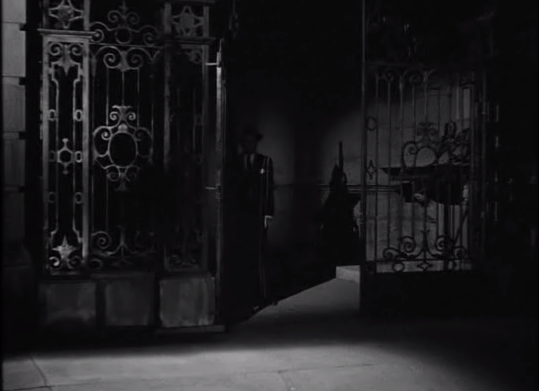
Wilder deployed essentially the same technique in his film. For example, in the scene where Joseph approaches Norma’s house, he gets to hear her talking to
him for the first time (00.13.09). However, he also remains puzzled as to the Norma’s appearance for a while, because she is being half-concealed with window-blinds.
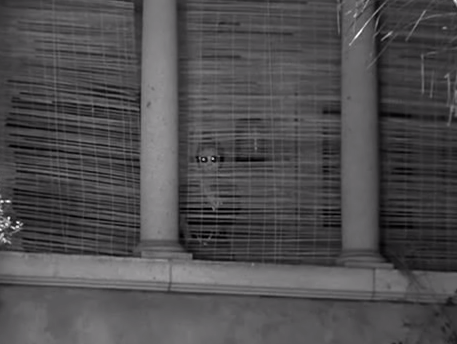
In both cases, the obscured appearances of Bruno and Norma were meant to intensify the atmosphere of an ominous suspense – hence, preparing a psychological ground for the audience’s members to remain emotionally attuned with the plots’ consequential developments.
Another element of an expressionist editing, which can be seen in both films, is the semiotically conflicting construction of two of more consequential shots, for endowing the screen-action with implicitly present absurdist overtones. While expounding on the purpose of this specific editing-element’s deployment, Giannetti (p. 158) states, “The conflict of two shots (thesis and antithesis) produces a wholly new idea (synthesis). Thus, in film terms, the conflict between shot A and shot B is not AB but a qualitatively new factor—C”. Regarding Hitchcock’s film, the validity of this suggestion can be illustrated in relation to the climax-scene, in which both antagonists (Bruno and Guy) struggle with each other on the spinning carousel (01.30.00 – 01.33.06). As it can be seen below, the emotionally intense scene’s shots of two men fighting to death, laughing boy, woman screaming in horror and horse’s grimace, do not derive out of each other logically. Nevertheless, while being exposed to these shots, viewers experience the sensation of ‘existential absurdity’ – thoroughly consistent with the overall spirit of confusion, alienation and moral ambiguity, emanated by this particular movie.
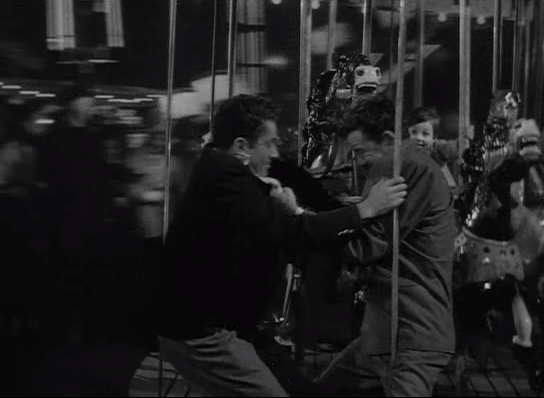

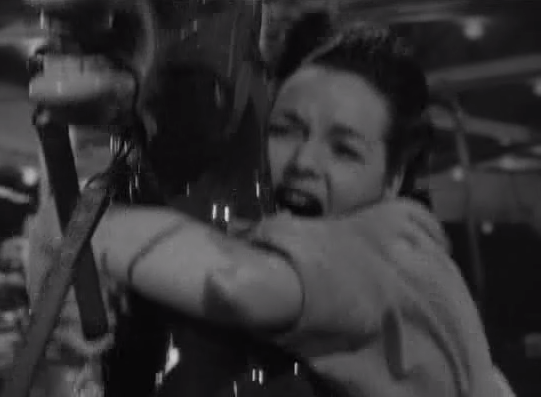
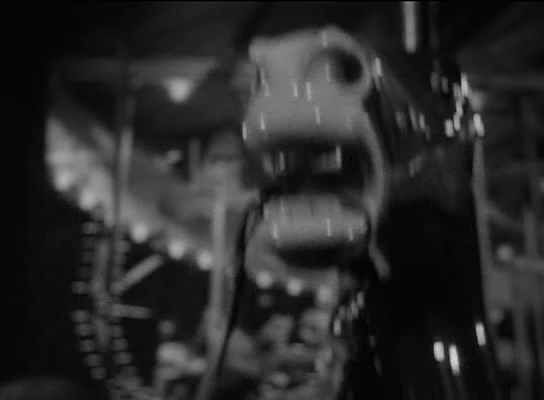
The deployment of the same editing technique can also be found in the Wilder movie’s scene, where lavishly dressed Joseph and Norma dance together, as if they were amongst other dancing couples (00.39.47- 00.44.20). After all, being a mentally deranged individual, Norma did expect many guests to attend a New Year party, held at her house. Nevertheless, the unexpected high-angle shot of them dancing reveals the fact that there are no other people in the richly decorated ballroom, with the band of musicians playing in the background. The viewers’ exposure to this shot, of course, confirms even further the validity of their growing suspicion that there is something utterly wrong about the relationship between both characters.
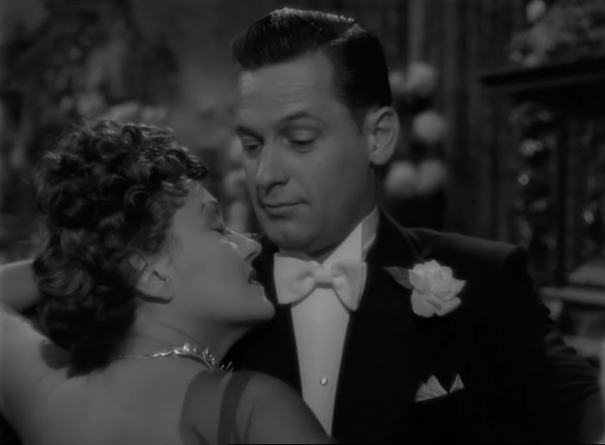
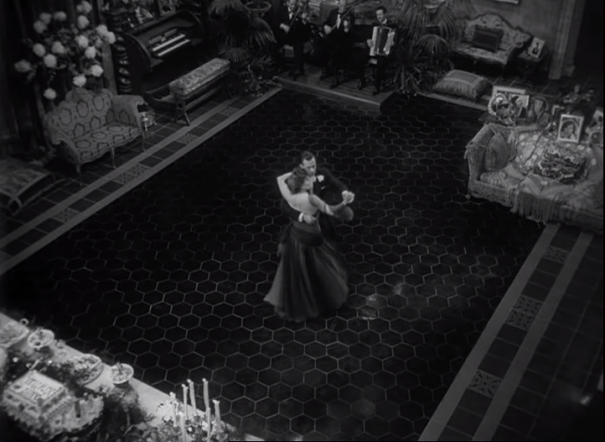
It is also being considered a common feature of expressionist editing to emphasize the unconventionality of mise-en-scenic sets. For example, on the below screenshot of Hitchcock’s film, mortally wounded Bruno is being shown laying on his back, with the carousel’s debris pressing down on his chest.
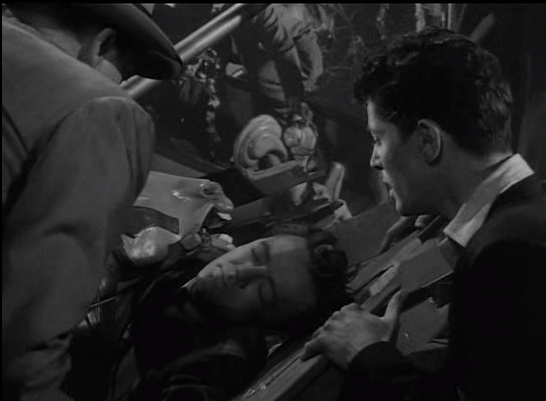
By presenting Bruno within this specific mise-en-scenic context, Hitchcock wanted to highlight dialectical links between the unnaturalness of Bruno’s existential anxieties and the unnaturalness of his death.
The same editing feature can be found at the very outset Wilder’s film, in the scene where Joseph’s body (who simultaneously acts as an off-screen narrator) is shown floating in Norma’s pool.
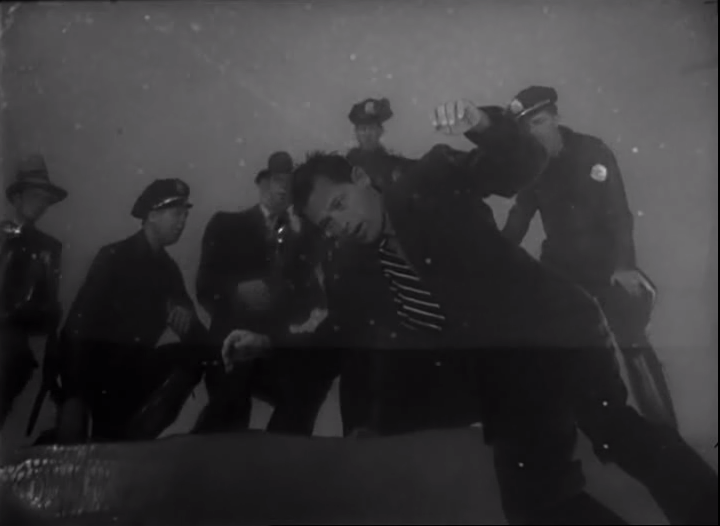
As it can be seen on the above screenshot, it is not only that the director strived to expose viewers to the graphic details of Joseph’s post-mortem, but he also made a point in shooting this particular take from underwater low-angle. By doing this, Hitchcock wanted to trigger a specific perceptional mood in viewers, so that that they would remain in suspense, even throughout the emotionally non-intense parts of the film.
Given the fact that the expressionist editing’s foremost purpose is endowing the cinematic action with a specific mood, it is fully explainable why musical scores, used in classical Noir films that feature the elements of this editing, appear discursively consistent with these films’ themes and motifs. That is, they are being just as capable of intensifying Noir films’ existentialist mood, as it happened to be the case with the earlier mentioned visual editing techniques. As it was noted by Ness (2008, p. 53), “The music for noir films does not only undermine the security of more conventional film scores through the incorporation of dissonance and atonality, but also through such destabilizing devices as the breakdown of traditional diegetic/nondiegetic distinctions and the use of unusual instrumentation and experimental recording techniques”. The musical accompaniment in the scene (Sunset boulevard) where Norma signs her photos with autographs (00.29.13), illustrate the soundness of Ness’s suggestion perfectly well, as it features the elements of early 20th century’s musical modernism, associated with the composers’ exploration of ‘melodic atonality’ principle. The same principle has been used for composing the theme that provides a musical accompaniment to the ‘Carousel scene’ in Hitchcock’s movie.
The fact that, as it was shown with the examples of Sunset boulevard and Strangers on a train, the elements of expressionist editing are being visible in many classical Noir movies does not imply these movies are expressionist per se. After all, the majority of these films do feature a linearly unravelling plot and the spatial integrity of consequential takes. Nevertheless, these elements do emphasise the acuteness of existentialist themes and motifs in classical Noir films, associated with the sensation of absurdist alienation, experienced by the decadent representatives of the ‘third generation’ of Westerners.
Neo-Noir
In the earlier parts of this study, it was suggested that one of the reasons why, throughout late fifties, Noir films started to become less popular with the viewing audiences, is that the representatives of ‘baby-boomer’ generation, who were beginning to constitute a considerable share of moviegoers at the time, professed the values of perceptional/cognitive optimism (the psychological trait of those who belong to the ‘second generation’). Nevertheless, throughout seventies, eighties and nineties, Noir motifs began to reaper again in Hollywood crime-fiction movies. From the discursive perspective, this can be explained by the fact that this specific historical period is being associated with the rise of new generations of Westerners/Americans – the so-called Generations X and Y. The representatives of these generations are now being well known for their hypertrophied sense of individualism, strongly defined intellectualism, tendency to indulge in social withdrawal and obsession with exploring psychological subject matters (Semente, Fredrickson and Joyce, 2002). In their turn, the particulars of these people’s psychological makeup, on the one hand, and the specifics of a post-industrial living, associated with the rise of both generations, on the other, can be well discussed as such that predetermined the qualitative characteristics of neo-Noir genre/style in Western cinematography.
The chief discursive aspect of neo-Noir movies is the fact that, unlike what it was the case with the directors of classical Noir films, the production of these movies has been directed by individuals that were well aware of what later became known as the Noir genre’s thematic and editing conventions. As it was noted by Conard (2007, p. 2), “The filmmakers of the classic period didn’t have access to that expression (Noir) and couldn’t have understood or grasped entirely the meaning or shape of the movement to which they were contributing, whereas neo-Noir filmmakers are quite aware of the meaning of Noir and are quite consciously working within the noir framework and adding to the Noir canon”. Because of that, many neo-Noir movies (such as Ridley Scott’s 1982 Blade runner, for example) have an undeniable ‘bohemian’ spirit to them, in a respect that these movies’ directors expected the members of viewing audiences to be aware of the Noir genre’s stylistic provisions, which in turn implied the directors’ assumption of potential viewers being intellectually advanced individuals, capable of understanding and enjoying the specifics of Noir cinematic action, as ‘things in themselves’.
Another common characteristic of neo-Noir films is that their plots revolve around main characters searching for their long-lost sense of self-identity or striving to prevent such their sense from becoming weakened. The validity of this suggestion can be illustrated in regards to Doug Liman’s 2002 film The Bourne Identity and Steven Spielberg’s 2002 film Minority report. In both movies, the main characters of Jason Bourne (Matt Damon) and John Anderton (Tom Cruise) do not only try to catch and punish those they suspect of criminal scheming, but they also strive to get rid of a deep-seated suspicion that they are themselves may be the actual culprits. While doing it, they are being often forced to socialize with villains and to act as villains. This constitutes another distinctive aspect of neo-Noir films – the fact that neo-Noir main characters appear to share the idea that ‘good’ and ‘evil’ are merely points of view, which is why these characters always serve justice in an utterly concrete and personal manner. In its turn, this can be partially explained by the earlier mentioned tendency of representatives of Generation X (to which neo-Noir films appeal) to lead highly individualized lifestyles, which implies them being strongly self-focused. Therefore, there is nothing odd about Abrams’ (2007, p. 7) observation that, “(In neo-Noir films) everything takes place in relation to the self: the self is the detective, the self is the villain, and all the clues exist solely within his mind”. For example, in James Ellroy’s 1997 film L.A. Confidential, the character of ‘Bud’ (Russell Crowe) does act in accordance to what he perceives constitutes an ethically appropriate code of a police officer’s behaviour. However, throughout the film’s entirety, because of Bud’s continual exposure to different circumstances, such his perception never ceases to undergo a qualitative transformation in his mind, which in turn explains why Bud’s behaviour can be best described as rather unpredictable.
What also differs classical Noir movies from neo-Noir ones, is that unlike what it is being often the case in classical Noir movies, neo-Noir characters do not experience much of an emotional discomfort, while faced with the unpresentable emanations of surrounding reality. In its turn, this positions them as realistically minded individuals, fully aware that ‘ugliness’ is being just as much part of the reality as ‘beauty’ is – hence, the well defined realist sounding of neo-Noir’s themes and motifs. For example, in L.A. Confidential, ‘Bud’ takes for granted the fact that, for police investigators to be able to make the caught suspects talk; they must be willing to torture them. He perceives the act of beating these suspects as being purely instrumental – as something that cannot have any moral implications, by definition. The fact that, as compared to classical Noir films, neo-Noir films are being much more realistic, can also be illustrated in regards to these films’ treatment of villain-characters, as such that not only can well get away with committing crimes, but as such that are being predetermined to escape punishment, unless a some sort of purely accidental factor comes into play and prevents them from doing so. As Holt (2006, p. 38) noted it, “While the outcomes of noir in general are realistically downbeat… neo-noirs exploit the much more realistic possibility that, often, the guilty fail to get their comeuppance”.
Finally, unlike it is being usually the case with the plots of classical Noir films, the plots of neo-Noir films are often being concerned with exploring existentialist motifs, within the context of how an ongoing technological progress changes the very essence of social dynamics – hence, causing the people’s sense of self-identity becoming increasingly undermined (1982 Blade runner, 2002 Minority report). The neo-Noir films’ exploration of this particular theme highlights the fact that, just as it was the case with people who used to find Noir films appealing, throughout Noir classical era, the representatives of Generations X and Y also lack the sense of existential integrity, which in turn causes them to experience an emotional unease, while considering the practical implications of a number of different technologies, they have created.
There appears to be a philosophical significance to the earlier outlined thematic differences between classical Noir and neo-Noir films. This significance can be defined as follows: whereas, classical Noir films subtly promote the idea that people’s existential imperfection, sublimated in their tendency to choose in favor of an anti-social behavior, come as the result of these people growing increasingly immoral, neo-Nor films treat the subject of people’s imperfection as such that naturally derives out of the process of religion-based positivist notions becoming exponentially outdated. In other words, the qualitative transformation of Noir genre/style into neo-Noir suggests that the discursive aspects of a modern living can still be discussed within the context of what defines the essentials of the ‘third generation’ Westerners’ existential mode. After all, the watching of many neo-Noir movies (especially the one that feature the elements of sci-fi) leaves very few doubts as to these people’s ability to push forward technology-based social progress. At the same time, however, these movies also point out to the fact that, while exploring the full potential of their intellectual powers, Westerners (Whites) often prove themselves incapable of being in full control of the process. This conclusion, of course, fully correlates with Spengler’s idea that, ever since early 20th century, the extent of Westerners’ biological/existential vitality started to become increasingly undermined.
Nevertheless, there is also another discursive aspect to neo-Noir themes and motifs – the fact that many of these movies treat the religion-based conventions of morality and the dogmas of socially-appropriate behavior as being quite inconsistent with the realities of a post-industrial living, suggest that Westerners may be standing on the threshold of an impending another evolutionary jump. However, this can only be possible if they manage to regain the masculine psychological traits of their ancestors, while retaining their ability to operate with highly abstract categories. As of today, there are appearing to be no objective preconditions to expect that to happen in the near future. Yet, this does not mean that this will continue remaining the case tomorrow – the clearly defined apocalyptical motifs in today’s sci-fi neo-Noir films do implicitly predict such an eventual development.
Neo-Noir editing/thematic specifics
One of the most notable aspects of the neo-Noir films’ editing philosophy is the fact that, even though neo-Noir directors do often resort to the deployment of expressionist techniques, while constructing mise-en-scenes, these mise-en-scenes do not create a discursive meaning of a ‘thing in itself’. The validity of this statement can be explored in regards to such neo-Noir movies as Robert Altman’s 1973 The long good bye and Curtis Hanson’s 1991 L.A. Confidential. The scene in Altman movie’s scene, where Philip Marlowe (Elliott Gould) is being visited by Marty Augustine (Mark Rydell) and his gangsters (00.48.31), features a classical Noir low-key mise-en-scene’s illumination, which makes it quite impossible for viewers to be able to positively identify the presented characters.
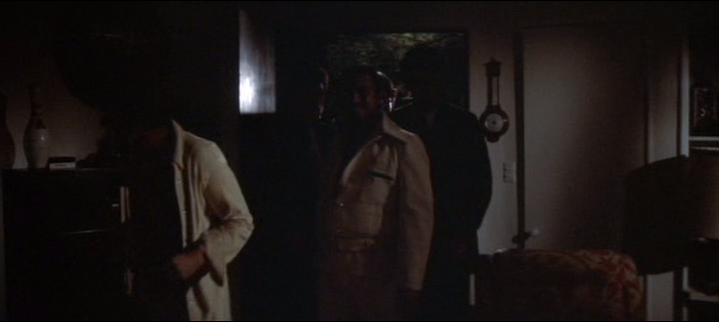
Yet, even though this particular shadowy mise-en-scene does help to emphasize the film’s overall existentialist mood, there is no Freudian ‘uncanny’ to be found in it, as opposed to what it is being the case with the mise-en-scenic subtleties of a shot, in which supposedly murder-minded Guy approaches Bruno’s farther in his bed (Strangers on a Train 01.05.08).
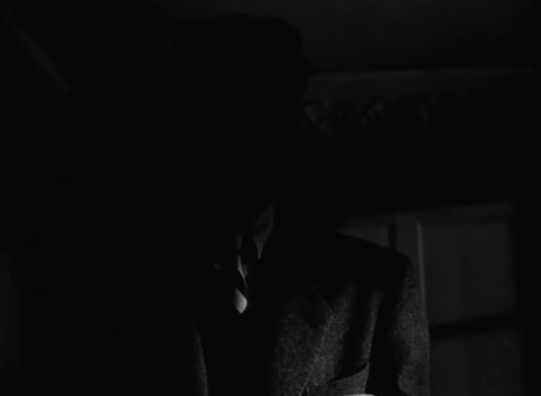
The legitimacy of the same idea can also be illustrated in regards to the Hanson film’s scene, in which the characters of ‘Bud’ and ‘Ed’ (Guy Pearce) are getting ready to fight back the attackers, which surrounded them in the abandoned house (02.00.02).
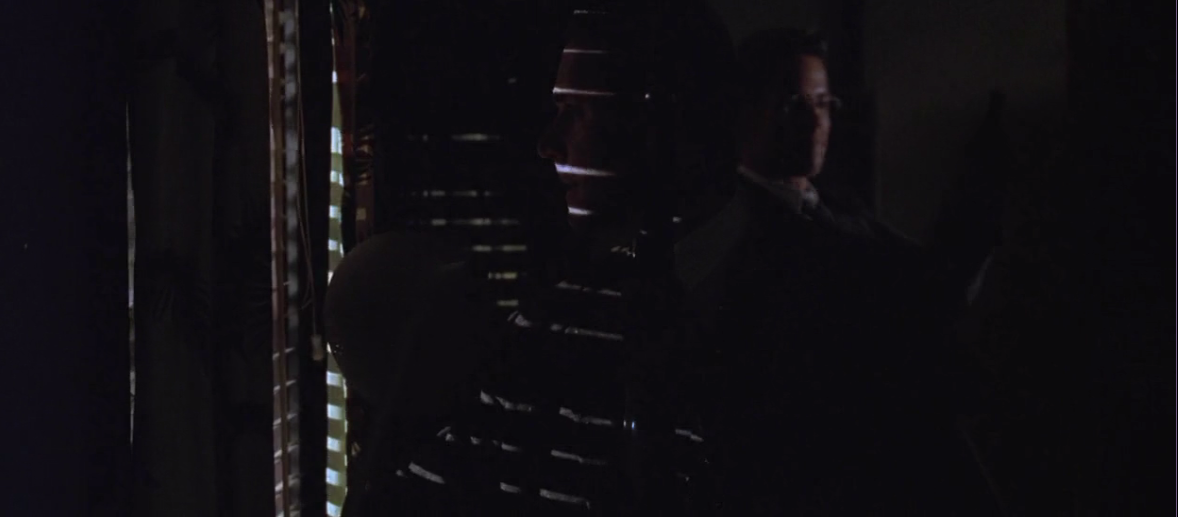
As it can be seen on the screenshot above, with the classical element of Noir-expressionism in it, as this particular shot features ‘Bud’ peaking out through half-closed window-blinds, with his facial expression being obscured with the ‘stripes’ of light and darkness. Yet, whereas, in classical Noir movies the mise-en-scenes that involve obscurely illuminated characters peaking out through window-blinds always emphasize these characters’ prolonged state of mind, the same motif in Hanson’s film is being deprived of any discursive meaning, whatsoever. In the scene (as seen on the above screenshot), ‘Bud’ is simply getting ready to defend his life, with his agenda of ‘darkening’ the house being rationalistic and not even slightly ‘uncanny’.
Another notable specific of neo-Noir editing is the fact that, unlike what it is being the case in classical Noir films, where violent escalations represent the climax of a cinematic action, the sporadic outbreaks of violence do not only occur in neo-Noir movies, throughout their duration, but these recurring outbreaks of violence also serve the purpose of uniting the plot’s twists logically. Moreover, they also help viewers to gain an in-depth insight as to the essence of main characters’ psychological makeup. A good example of this statement’s validity can serve the scene in Altmen’s film, in which Marty hits his mistress with a bottle against her head (00.52.49).
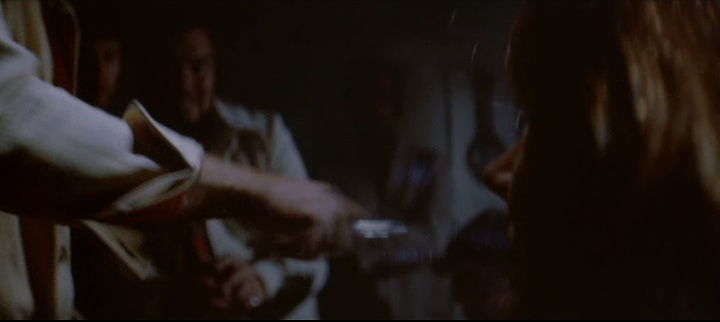
As a scene’s consequence, the film’s action enters into a qualitatively new phase, as this particular outbreak of graphic violence does not only reveal Marty’s true character, but also provides Marlowe with a preliminary clue as to what could have caused Terry Lennox’s (Jim Bouton) death.
A similar thesis applies to the violent scene in Hanson’s film, where ‘Bud’ gives a particularly vicious beating to a stranger, who ‘Bud’ had caught abusing his wife (00.04.04).

The viewers’ exposure to this scene helps them to identify the specifics of ‘Bud’s’ psychological phenotype – hence, making them more capable of following the plot, as it unravels.
The earlier provided line of argumentation, as to what accounts for the foremost specifics of neo-Noir editing, is being consistent with the initial thesis, in a respect that it suggests that it is indeed appropriate to consider the neo-Noir editing techniques as such that reveal the innate causes of the Noir genre’s transformation into neo-Noir. After all, whereas, the application of semi-expressionist editing techniques in classical Noir films was meant to strengthen the sensation of existential disorientation in viewers, the application of artificially semi-expressionist editing techniques in neo-Noir films has a diametrically opposite purpose. It is supposed to help viewers to assume that there can be very little oddness to the cinematic representations of negativity, as these representations reveal the negativity’s systemness. This is exactly the reason why in neo-Noir movies, the implementation of semi-expressionist editing techniques does not disrupt the spatial integrity of these movies’ linearly unraveling plots. The discursive significance of what has been suggested in this sub-chapter is quite apparent – even though that there can be no doubt as to the fact that neo-Noir style does relate to the classical Noir style in a variety of formal ways, its emergence cannot be discussed in solely cinematographic terms. The Neo-Noir themes and motifs reflect the qualitative essence of an ongoing process of today’s intellectually advanced but psychologically decadent Westerners striving to attain the sensation of existential comfortableness in what they perceive as the increasingly ‘hostile’ world.
Conclusion
As it was already pointed out, the discursive significance of Noir and neo-Noir cinematographic genres has been discussed from a number of different perspectives. Nevertheless, the main weakness of many of contemporary interpretations of these genres’ discursive characteristics appears to be the fact that the provided interpretations themselves are being affected by the currently predominant discourse of political correctness. This partially explains why the authors of previously referenced articles, written in comparatively recent times, have made a deliberate point in not referring to the concept cinematography, in general, and to Noir/neo-Noir cinematographic genres, in particular, as to what they are – the technology-backed aesthetic extrapolations of specifically Western (Faustian) existential spirit. After all, it now became a common practice among particularly ‘progressive’ Western politicians to defy the very term ‘Western’, as strongly ‘euro-centric’ and therefore – ‘innately wicked’. Therefore, I believe that despite the present study’s limitations, it does contain a number of discursively legitimate insights as to what should be considered a proper methodological approach towards analyzing what accounts for the Noir cinematographic genre/style’s actual significance. This is because, while coming up with my interpretations of the concerned genre/style’s discursive aspects, I strived to remain unaffected by any ideological considerations. This is the reason why I have chosen in favor of discussing both cinematographic genres/styles within the methodological framework of Spengler’s concept, as being both: discursively appropriate and politically unengaged.
I also believe that the deployed line of discursive argumentation is being thoroughly consistent with the study’s initial thesis, as to the fact that the rise of Noir/neo-Noir cinematographic genres/styles should be discussed within the context of how the spatial specifics of people’s existential mode define the essence of their aesthetic/cognitive inclinations. Given the fact that, as it was shown earlier, there are indeed a number of good reasons to consider Noir as being nothing short of a cinematographic indication of the process of psychologically ‘feminized’ people in Western countries becoming increasingly incapable to exercise a will-powered control over their Faustian anxieties, there can be very little secret as to what should be considered a true meaning of Noir/neo-Noir’s thematic and editing-related distinctiveness. I would recommend that the future studies, concerned with exploring the cinematographic genres’ discursive meaning, investigate how the particulars of viewing audience members’ ethno-cultural affiliation affect their cognitive predispositions, on the one hand, and their aesthetic tastes, on the other.
References
Abrams, J 2006, ‘From Sherlock Holmes to the hard-boiled detective’, in film Noir’, In: Conard, M ed. The philosophy of film Noir, The University Press of Kentucky, Lexington, pp. 69-91.
Abrams, J 2007, ‘Space, time, and subjectivity in neo-Noir cinema’, In: Conard, M ed. The philosophy of neo-Noir, The University Press of Kentucky, Lexington, pp. 7-21.
Biesen, S 2010, ‘Driven to darkness: Jewish émigré directors and the rise of Film Noir (review)’, American Jewish History, vol. 96 no. 1, pp. 89-91.
Brook, V 2009, Driven to darkness: Jewish émigré directors and the rise of film Noir, Rutgers University Press, New Brunswick, New Jersey & London.
Conard, M 2006, ‘Nietzsche and the meaning and definition of Noir’, In: Conard, M ed. The philosophy of film Noir, The University Press of Kentucky, Lexington, pp. 7-23.
Conard, M 2007, ‘Introduction’, In: Conard, M ed. The philosophy of neo-Noir, The University Press of Kentucky, Lexington, pp. 1-7.
Foucault M 1978, The history of sexuality, Pantheon, New York.
Gianetti, L 2001, Understanding movies. 9th ed., Prentice Hall, Upper Saddle River.
Greenwood, S 2009, Anthropology of magic, Berg Publishers, Oxford.
Hadden, J 1987, “Toward desacralizing secularization theory’, Social Forces, vol. 65 no. 3, pp. 587-611
Hirsch, F 1981, The dark side of the screen: Film Noir, Da Capo, New York.
Holt, J 2006, ‘A darker shade: Realism in neo-Noir’, In: Conard, M ed. The philosophy of film Noir, The University Press of Kentucky, Lexington, pp. 23-41.
Naremore, J 1995-1996, ‘American film Noir: The history of an idea’, Film Quarterly, vol. 49 no. 2, pp. 12-28.
Porfirio, R 1996, ‘No way out: Existential motifs in the film Noir’, In: Silver, A & Ursini, J eds. Film Noir reader, Limelight, New York, pp. 77-93.
Schuchardt, M 2006, ‘Cherchez la femme fatale: The mother of film Noir’, In: Conard, M ed. The philosophy of film Noir, The University Press of Kentucky, Lexington, pp. 49-69.
Semente, J, Fredrickson, L & Joyce, L 2002, ‘Boomers vs. X-Ers’, The American Journal of Nursing, vol. 102 no. 4, pp. 13-20.
Spengler, O 1923 (1991), The decline of the West, Oxford University Press, Oxford.
Spicer, A 2002, Film Noir, Longman, Harlow.
Staley, R 2009, Einstein’s generation: The origin of the relativity revolution, University of Chicago Press, Chicago & London.
Weber, M 1905 (2001), The protestant ethic and the spirit of capitalism, Roxbury Publishing, Los Angeles.